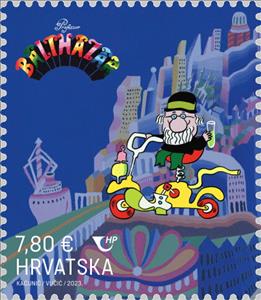Stamp: Professor Balthazar's Robocycle (Croatia 2023)
Professor Balthazar's Robocycle (Croatia 2023)
07 September (Croatia ) within release Cryptostamp : Professor Balthazar goes into circulation Stamp Professor Balthazar's Robocycle face value 7.80 Euro
| Stamp Professor Balthazar's Robocycle in catalogues | |
|---|---|
| Yvert et Tellier: | Yt: HR CRY28 |
Stamp is vertical format.
Stamp from souvenir sheet Adhesive stamp, removable from a crypto debit card, all in a cardboard sleeve. The stamp is also available in 5 stamps, each with a different print, an invention of Professor Balthazar.Also in the issue Cryptostamp : Professor Balthazar:
- Souvenir Sheet - Cryptostamp : Professor Balthazar face value 7.80;
- Stamp - Cryptostamp : Professor Balthazar face value 7.80;
- Stamp - Balthazar's Machine with a Windmill face value 7.80;
- Stamp - Professor Balthazar with a Test Tube face value 7.80;
- Stamp - Professor Balthazar's Bed face value 7.80;
- Stamp - Professor Balthazar's Robocycle face value 7.80;
- Stamp - Professor Balthazar's Submarine face value 7.80;
Stamp Professor Balthazar's Robocycle it reflects the thematic directions:
A cartoon is a type of visual art that is typically drawn, frequently animated, in an unrealistic or semi-realistic style. The specific meaning has evolved, but the modern usage usually refers to either: an image or series of images intended for satire, caricature, or humor; or a motion picture that relies on a sequence of illustrations for its animation. Someone who creates cartoons in the first sense is called a cartoonist, and in the second sense they are usually called an animator.
The concept originated in the Middle Ages, and first described a preparatory drawing for a piece of art, such as a painting, fresco, tapestry, or stained glass window. In the 19th century, beginning in Punch magazine in 1843, cartoon came to refer – ironically at first – to humorous artworks in magazines and newspapers. Then it also was used for political cartoons and comic strips. When the medium developed, in the early 20th century, it began to refer to animated films that resembled print cartoons.
Comics are a medium used to express ideas with images, often combined with text or other visual information. It typically takes the form of a sequence of panels of images. Textual devices such as speech balloons, captions, and onomatopoeia can indicate dialogue, narration, sound effects, or other information. There is no consensus among theorists and historians on a definition of comics; some emphasize the combination of images and text, some sequentiality or other image relations, and others historical aspects such as mass reproduction or the use of recurring characters. Cartooning and other forms of illustration are the most common image-making means in comics; Photo comics is a form that uses photographic images. Common forms include comic strips, editorial and gag cartoons, and comic books. Since the late 20th century, bound volumes such as graphic novels, comic albums, and tankōbon have become increasingly common, along with webcomics as well as scientific/medical comics
Crypto-communism (or cryptocommunism) is a secret support for, or admiration of, communism. Individuals and groups have been labelled as crypto-communists, often as a result of being associated with, or influenced by communists. Crypto-communism among political leaders aided the sovietization of the Baltic states.


